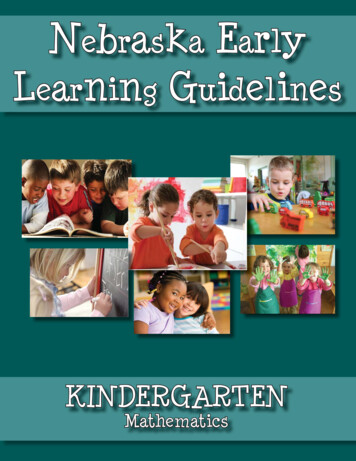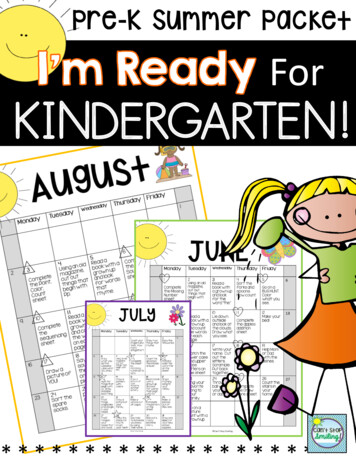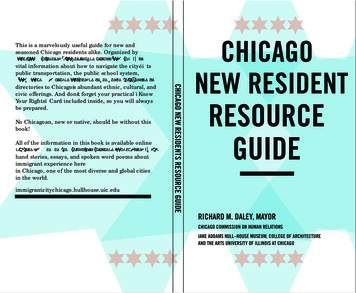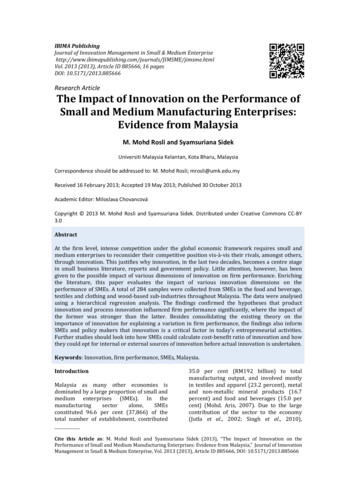
Transcription
Nebraska EarlyLearning GuidelinesKINDERGARTENMathematics
The Kindergarten Early Learning Guidelines were created for Nebraska‛s kindergartenteachers and school administrators to help enrich the work that takes place in classrooms everyday. These guidelines incorporate the Nebraska Standards in language arts and mathematicswithin each domain, and provide examples of how the state standards can be intentionally taughtand informally integrated throughout a range of daily experiences to support optimal learningoutcomes for young children. They are a practical resource to support the teacher; they alsoprovide examples of authentic activities and assessments which can be incorporated into theexisting curriculum to aid the child‛s academic and social growth. Within the guidelines,examples of what the learning environment should include, what children should be doing in theclassroom, and the role of adults within the school and home community are provided so thereader is able to see how adults, materials, and environments can work together to achieveoptimal learning and positive lifetime outcomes for young children.Knowledge about child development and learning and evidence-based practices in kindergartenguided the writing of this document: Teaching and learning environments should encompass the holistic developmental needs of thechild including academic concepts and skills along with social and emotional development. The kindergarten teacher has a complex and complicated role in the kindergarten classroomwhich includes providing opportunities and experiences that allow children to come togetheras a community of learners. Learning experiences should be integrated and connected throughout the day. Literacy andother academic activities can occur throughout the day across all content areas and shouldnot be segregated into separate time frames and experiences. Opportunities to express new information in a variety of ways (e.g., pictorially, throughstorytelling, emergent writing), are an essential element of the kindergarten classroom, bothfor the child to show an understanding of concepts, and as a way for the teacher to assessthe child‛s understanding. Academic learning and social and emotional development occur through a variety of dailyexperiences including teacher directed experiences, child initiated experiences, playexperiences, and frequent interactions with adults and peers. Observation and documentation, as well as other forms of formative and summativeassessment, are essential for effective curriculum planning and instruction. Daily opportunities for play provide children with practice of newly acquiredskills taught in the classroom, along with supporting the child‛s development of self-regulation,creativity, and problem solving.Most of what I really need to know about how to live, what to do, and how to be, Ilearned in kindergarten. Wisdom did not lie at the top of the graduate school mountain,but there in a kindergarten classroom. Robert FulghumThese guidelines are dedicated to all kindergarten teachers in Nebraska. Thank you foryour passion and dedication to education through your work with our youngest students.i
Kindergarten Early Learning GuidelinesWriting/Review TeamSusan AllenKindergarten TeacherBennington Elementary SchoolBennington, NEMarjorie Kostelnik, DeanCollege of Education and Human SciencesUniversity of Nebraska-LincolnLincoln, NebraskaJune AsperAdjunct Faculty-Early ChildhoodCollege of St. MaryOmaha, NECarolyn LawRetired Elementary Principal/Early Childhood TeacherWestside SchoolsOmaha, NEJen BensonEducation SpecialistNebraska Department of EducationLincoln, NECatie LimbachKindergarten TeacherCrawford Public SchoolsCrawford, NEJan CarmanStaff Development/Early EducationFacilitatorWestside SchoolsOmaha, NEGail MayKindergarten TeacherOmaha Public SchoolsOmaha, NEM. Susan McWilliamsAssistant Professor, Early ChildhoodEducationUniversity of Nebraska-OmahaOmaha, NebraskaNancy DeuelKindergarten TeacherPierce Elementary SchoolPierce, NEJulie ElversKindergarten TeacherMillard Public SchoolsOmaha, NELisa OltmanCurriculum SpecialistLincoln Public SchoolsLincoln, NETrish GoreckiEducation Coordinator for CNCSLoup City, NETricia ParkerReading/Writing SpecialistNebraska Department of EducationLavennia CooverUmo ho Nation Early Childhood ProgramMacy, NEMary Beth PistilloNDE-Early Childhood Training CenterOmaha, NEHarriet EgertsonEarly Childhood Independent ConsultantTemecula, CaliforniaDeb RomanekMathematics Education SpecialistNebraska Department of EducationLinda HankinsKindergarten TeacherOmaha Public SchoolsOmaha, NEAmanda KraclKindergarten TeacherWestside SchoolsOmaha, NEMichelle Rupiper, ProfessorUniversity of Nebraska-LincolnLincoln, NEiiAnn ThoberCurriculum SpecialistNorris Public SchoolsFirth, NE
Kindergarten StandardsMathematicsNumber lysisCharacteristicsModeling in ContextSpatial ModelingProceduresMost children come into the kindergarten classroom already having begun to build afoundation in mathematical understanding with real-life experiences. Through manipulatingobjects, stacking toys, building with blocks, and making comparisons through observations,children have experienced mathematical concepts first hand. Teachers can continue to buildon this foundation in the classroom by offering a balance of explicit guided instruction withinlarge and small group settings, and through purposeful play.Quality kindergarten mathematics is not elementary arithmetic pushed down to youngerchildren. The approach to teaching math should be experiential and playful rather thandidactic. Children should be invited to experience mathematics through peer initiated andteacher-led activities that allow them to manipulate and experiment with the materials, andthen be able to transfer that knowledge to their play activities as they use the concepts andlanguage of math while interacting with peers. Mathematical experiences can also beintegrated throughout the daily schedule topromote mathematical thinking and skills as apractical application.Long periods of time for play and enrichedenvironments are critical for developingchildren‛s mathematical ideas and skills(Sarama and Clements, 2009). Effectiveteachers use both real and pretend situationsto encourage children‛s mathematicalthinking. They try to capture teachablemoments using open-ended questioningtechniques to expand mathematical concepts. The teacher‛s role also includes encouragingfamilies to continue to develop and extend mathematical learning outside of school.Assessment of mathematical skills occurs in many different forms. Effective teacherscarefully observe children‛s actions, listen to children‛s words, and collect a variety ofwork samples in order to gain insight into the child‛s level of mathematical understanding.Through this type of observation and collection of documentation, the teacher can assessthe child and plan lessons which build upon that current knowledge, while making connectionsto new concepts.
Number Sense Standards1 Number System3 Computation (Mastery not expected at this time)2 Operations4 Estimation (Mastery not expected at this time)MA 0.1 Students will communicate number sense concepts using multiplerepresentations to reason, solve problems, and make connections withinmathematics and across disciplines.Young children develop mathematical concepts through meaningfuland active learning experiences throughout their day. Theseexperiences encourage them to engage in the language andproperties of mathematics, which helps to create a strongfoundation upon which children can build.Teachers intertwine meaningful ways to incorporate mathactivities in a variety of contexts and curriculum areas in thekindergarten day. Children graph attendance, measure plantgrowth, count blocks, and go on a shape hunt to reinforcemathematical concepts. In a classroom where play is part ofthe curriculum, children have many opportunities to try outnew learning with hands-on materials and re-enactreal-life situations where mathematics is applied.Teachers can support the children‛s learning byencompassing teachable moments in the classroom as well asintentional teaching of mathematical concepts. Teachers also needto plan activities that incorporate the children‛s natural curiosityand enthusiasm for learning about objects in their environmentboth indoors and out.Strategies to support inclusive learning environments: Simplify the activity by teaching smaller parts, reducing the number of steps, orusing smaller amounts. Provide a variety of manipulatives, including those which provide sensory cues suchas texture, bright colors, sounds, etc., to attract the child‛s interest. Use everyday activities and materials that are available throughout the child‛s dayto provide additional practice opportunities, e.g., how many crackers should Johnnygive you. Make sure materials are stable or contained, if necessary, by using a tray, Velcro,or clips.
Number SystemScenarioPedro and Kayla are sitting next to each other during snacktime, when Pedro begins counting his crackers, one, two, three, twelve. He then counts Kayla‛s crackers and yells out, “Kaylahas more crackers than I do! She has fourteen and I only havetwelve!”MathematicsThe Learning EnvironmentNumber sense is defined as “good intuition about numbersand their relationships. It develops gradually as a result ofexploring numbers, visualizing them in a variety of contexts,and relating in ways that are not limited by traditionalalgorithms.” (Howden, 1989, 11)Maththroughoutthe dayCreative Arts:Using clay orplaydough to createobjects that can besequenced usingordinal numbers.The classroom environment encourages mathematicalunderstanding through activities that are built into every part ofthe school day. Manipulatives are accessible to stimulate interestand play upon children‛s natural curiosity and further theirmathematical comprehension of our number system.Classroom materials: Materials for sorting and counting (small blocks, colored bears,colored beads, magnetic shapes) Objects that include numbers and number words (clocks,timers, calendars, thermometers, calculators, measuring cups,number lines) A variety of writing materials Dramatic play props for themed centers (store, bank, and postoffice) Classroom calendar Card games, board games, counting books, number lines,manipulatives, play moneyLanguage Arts:Create a class bookusing photosshowing numbers ofitems in theclassroom: 1 chair, 2books, 3 children.Number System - StandardsMA 0.1.1 Number System: Students will demonstrate,represent, and show relationships among whole numbers withinthe base-ten number system.MA 0.1.1a Count, read and write numbers 0-20MA 0.1.1b Count objects using one-to-one correspondence 0-20MA 0.1.1.c Sequence objects using ordinal numbers (first throughfifth)MA 0.1.1.d Match numerals to the quantities they represent 0-20,using a variety of models and representationsMA 0.1.1.1e Demonstrate and identify multiple equivalentrepresentations for numbers 1-10 (e.g., 10 is 1 and 9, 10 is 6 an 4)MA 0.1.1.f Demonstrate relative position of whole numbers 0-10(e.g., 5 is between 3 and 10; 7 is greater than 3)Physical:Play Simon Says(stomp three times,hop two times).
Number SystemLearning in ActionThe Child Explores/discovers number sense through manipulatives, games, books, and playParticipates in meaningful counting opportunities throughout the dayRecognizes, writes, and matches numerals to the quantity representedCompares and orders the position of numbers Offer counting opportunities through graphing, cooking experiences,finger plays, books, songs, games, and cards Provide opportunities to think mathematically, and problem solvethrough story problems and real life situations (attendance, lunch count, daysuntil vacation) Provide opportunities to write numerals using air writing, markers, sandtrays, Magna Doodle , clay, Wikki Stix , crayons, colored pencilsAdults in the Home Have the child set the table using one-to-one correspondence and counting Ask your child to help cook (counting and measuring quantity ofingredients: 1 cup, 2 cups) Encourage the child to count items in the home: socks, toys, crackers. Create a numbered “to do” or “shopping list”Approaches to Assessment Collect work samples of number writing Listen and record how high children count Document mathematical knowledge during daily experiences (How many blocks did ittake to build that tower? How many children have returned from the restroom? Howmany students are taking hot lunch today?)MathematicsAdults in the School Community
OperationsScenarioMathematicsJulia is playing with two dolls in the house area. When Sophiajoins her with two more dolls, Julia says, “I have two, you havetwo, now we have four dolls!”Maththroughoutthe dayCreative Arts:Plan dramatic play orThe Learning Environmentpretend playThe classroom provides opportunities throughout the day thatscenarios thatwill help strengthen the child‛s understanding of math operations. involve addition andThe teacher can support the student by paraphrasing children‛ssubtraction.activities, as well as naming the operation and providing thevocabulary words for what they are doing.Classroom materials: Manipulatives for sorting, patterning, seriating and counting(small blocks, colored bears, magnetic shapes, linking cubes) Objects that include numbers and number words (clocks,timers, calendars, thermometers, calculators, measuring cups,number lines) A variety of writing materials Dramatic play props for centers such as shoe store, bank, andpost office Classroom calendar Card games, board games, dice, dominoes, counting books,number lines, manipulatives, play money, pretend playLanguage Arts:Make a class book ofstory problemsusing addition andsubtraction.Operations - StandardsMA 0.1.2 Operations: Students will demonstrate the meaningof addition and subtraction
Susan Allen Kindergarten Teacher Bennington Elementary School Bennington, NE June Asper Adjunct Faculty-Early Childhood College of St. Mary Omaha, NE Jen Benson











